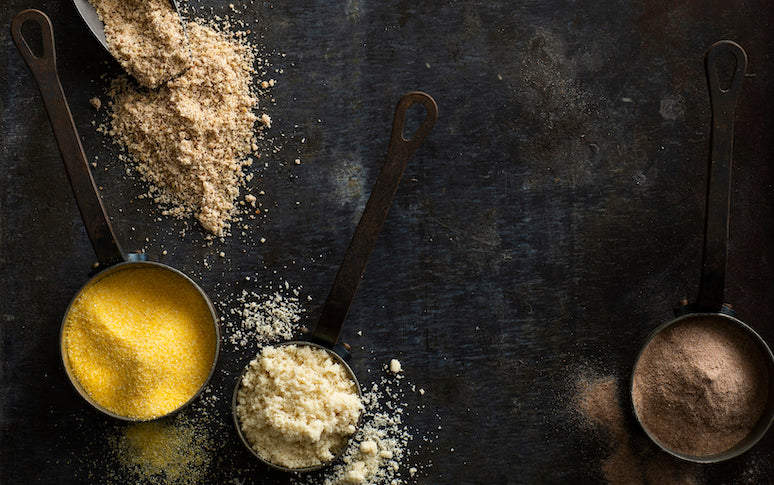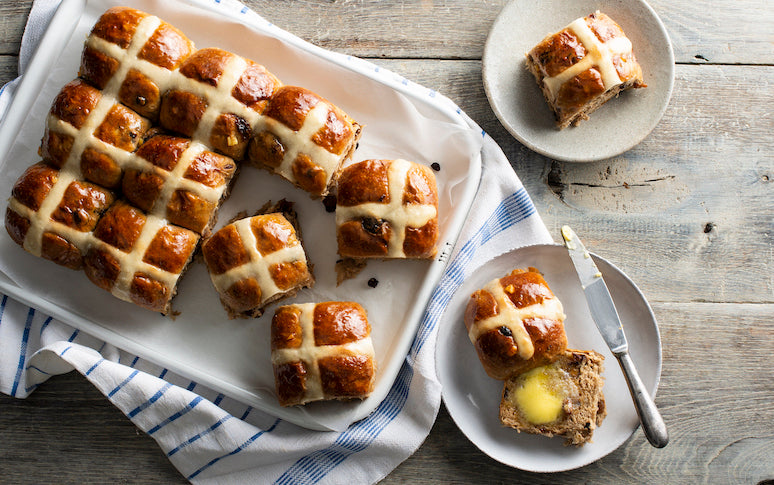- home
- Products
$100.00/pp
more info- Products -
Gluten-free Baking Essentials is a self-paced online course that will introduce you to the tricky world of gluten-free baking.
Discover this no-fuss 'real' guide to the world of gluten-free baking – in your own time!
Gluten-free Baking Essentials is a self-paced online course that will introduce you to the tricky world of gluten-free baking and will give you an understanding of gluten-free ingredients and how to use them successfully – all from your own home kitchen!
Completed in your own time, at your own pace, this course will give you a thorough understanding of what can be substituted for gluten-based ingredients in your baking and introduce you to the best gluten-free flour options. You will learn how to make your own gluten-free flour blends and for which type of recipe each blend is best suited, as well as how to adapt recipes to gluten-free (and how to get the best results!). You will also receive an invaluable collection of gluten-free recipes that you can build upon and use on a daily basis including gluten-free bread, pastry, pizza base, muffins, biscuits and a special celebration cake.
Guided by Anneka Manning, she will share her more than 30 years of baking experience, knowledge and research, as well as all of her practical and handy tips and tricks.
By the end of this course, you will walk away with all the knowledge, skill and confidence you need to get the best out of recipes without gluten and enjoy successful – and delicious – gluten-free baking!
Gluten-free Baking Essentials is accredited by Coeliac Australia.
How to enrol
Gluten-free Baking Essentials is a self-paced course and is now open for enrolment.
Cost
$100
Who is this course suitable for?
This course is, quite simply, suitable for bakers of all skill levels who want to expand their gluten-free knowledge and understand how gluten-free ingredients work and how to use them successfully in their baking. This course is not only for those who need to avoid gluten in their own diets, but also those who want to bake for family and friends who are gluten-intolerant.
As this course is completed online, it is suitable for students from all over the world.
What will I get?
- An understanding of gluten-free baking, substitutions and gluten-free flour options
- Downloadable and printable information resources including The Principles of Gluten-free Baking, A Guide to Gluten-free Flours, Starches and Other Ingredients, Making Your Own Gluten-free Flour Blends and Tips for Gluten-free Baking
- An invaluable collection of delicious gluten-free recipes (many of which are also dairy-free) that you can build upon and use on a daily basis (see full list below)
- Membership to BakeClub's exclusive The Kitchen Table online group which will provide ongoing support and inspiration
- Gluten-free baking confidence, knowledge and skill to use regularly at home
Which recipes are included?
- Artisan-style Gluten-free Bread
- Gluten & Dairy-free Banana & Coconut Berry Muffins
- Gluten-free Banana Bread
- Gluten-free Chocolate Chunk Cookies
- Gluten-free Orange Toffee & Chocolate Celebration Cake
- Gluten-free Ricotta, Basil & Tomato Pizza
- Gluten-free Shortcrust Pastry
- Gluten-free Vanilla Cupcakes with Chocolate Frosting
- Gluten-free Zucchini, Feta & Pesto Galette
- Seeded Gluten-free Crackers
How does a self-paced course work?
This online course is completely self-guided. Upon enrolment, you will gain access to the course content which you can work through at your own pace. You can log on whenever it is convenient for you and complete the modules one day at a time.
You can take as long as you need to complete the course – it's up to you how quickly you want to work through the content. You will have lifetime access to all the recipes and printable information sheets so you can dip in and out of it whenever it suits you.
There is the option to connect with other bakers via Facebook through BakeClub's exclusive The Kitchen Table membership group and via Instagram using #bakeschoolglutenfree. This way you can share your experience and support each other as your confidence and skills grow.
So, is Gluten-Free Baking Essentials for me?
- Do you need to avoid gluten in your diet but still want to bake delicious things you can eat?
- Do you want to bake successfully for family and friends who are gluten-intolerant?
- Would you like to gain a thorough understanding of what can be substituted for gluten-based ingredients in your baking and gain the confidence to do so?
- Would you like to be guided and inspired by Anneka's 30+ years of baking experience in your own kitchen?
- Do you have more time on your hands at the moment and keen to learn a new skill?
If any of these sound like you, then this course is the one for you!
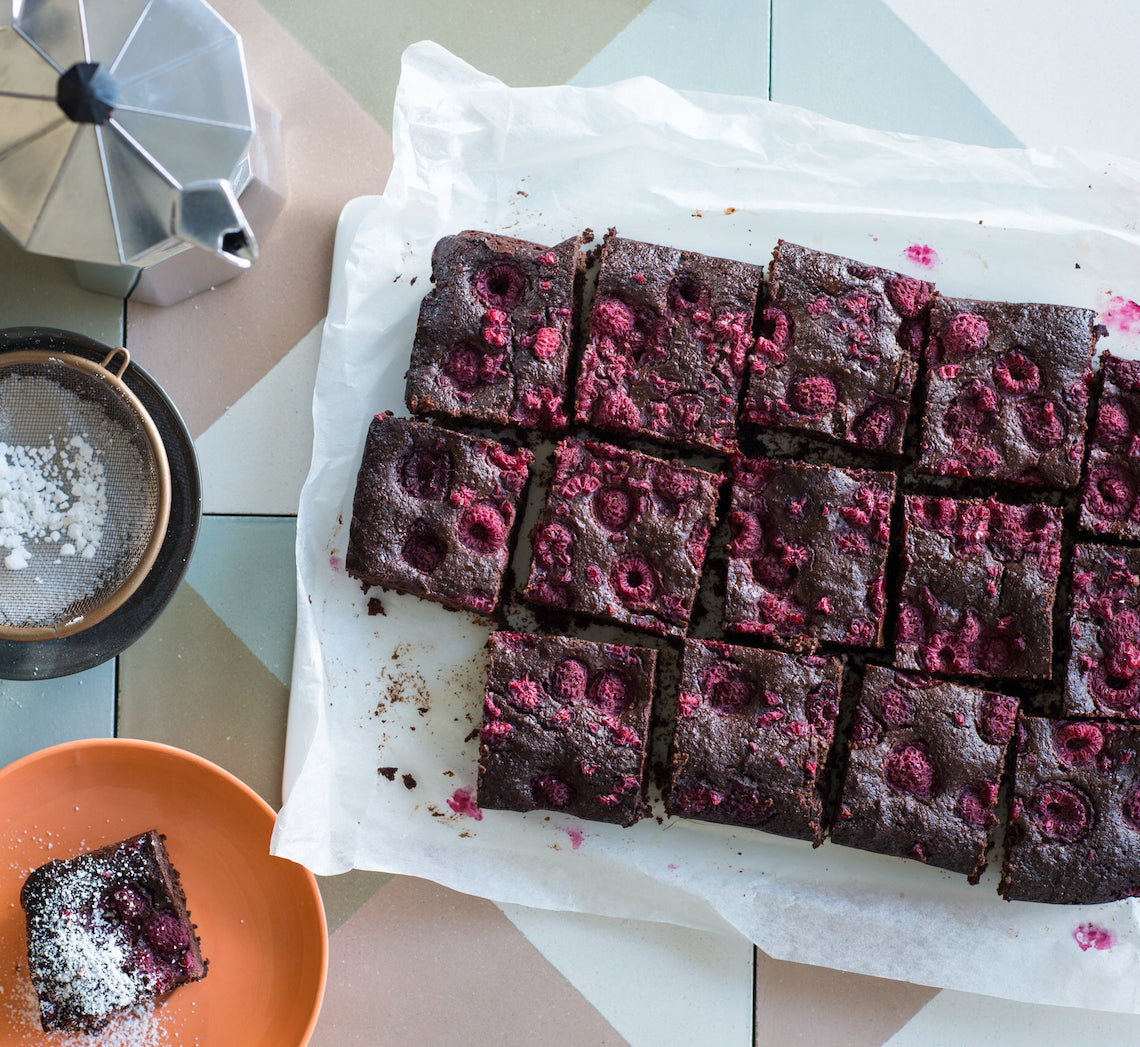
Prep 15minBake 35minMakes about 15
Wickedly rich, this gluten-free brownie can match it with the best of them. Fudgy, rich and studded with tart raspberries, you won't be able to stop at just one piece!
Ingredients
Coconut oil, to grease150g gluten-free, good-quality dark chocolate, chopped
100g (½ cup) coconut oil
135g (¾ cup) coconut sugar
2 eggs, at room temperature, light whisked
60ml (¼ cup) coconut milk
1 teaspoon natural vanilla essence or extract
30g (¼ cup) cocoa powder
2 tablespoons coconut flour
¾ teaspoon gluten-free baking powder
50g (½ cup) almond meal
150g frozen raspberries
Pure icing sugar, to dust (optional)
Method
- Preheat oven to 160°C (140°C fan-forced). Grease a 16cm x 26cm shallow slice tin with coconut oil and line the base and long sides with one piece of baking paper.
- Place the dark chocolate and coconut oil in a medium heatproof bowl over a saucepan of simmering water (don't let the base of the bowl touch the water). Stir occasionally until chocolate and coconut oil melt and the mixture is smooth. Remove bowl from the saucepan.
- Add the sugar, eggs, coconut milk and vanilla to chocolate mixture and use a balloon whisk to stir until well combined. Sift together the cocoa powder, coconut flour and baking powder into a bowl, add the almond meal and stir to combine. Add to chocolate mixture and stir with a spatula until just combined. Add the frozen raspberries and fold gently until just combined.
- Pour mixture into prepared tin and use the back of a metal spoon to spread evenly. Bake in preheated oven for 35 minutes or until moist crumbs cling to a skewer inserted in the centre. Cool in tin and then chill for at least 1 hour (see Baker's Tips).
- Remove brownie from the tin using the baking paper to carefully lift it out. Cut into portions and serve dusted with icing sugar, if desired.
Baker's Tips
- These brownies are a little more fragile than normal fudge brownies and will be easier to cut if you chill them for at least an hour before removing from the tin to cut.
- These brownies will keep in an airtight container in the fridge for up to 5 days. Serve straight from the fridge or stand at room temperature for 30 minutes before serving.
This recipe was originally published in Anneka's SBS Food online column, Bakeproof: Coconut.
Click here for more Bakeproof recipes.
Photography by Alan Benson.
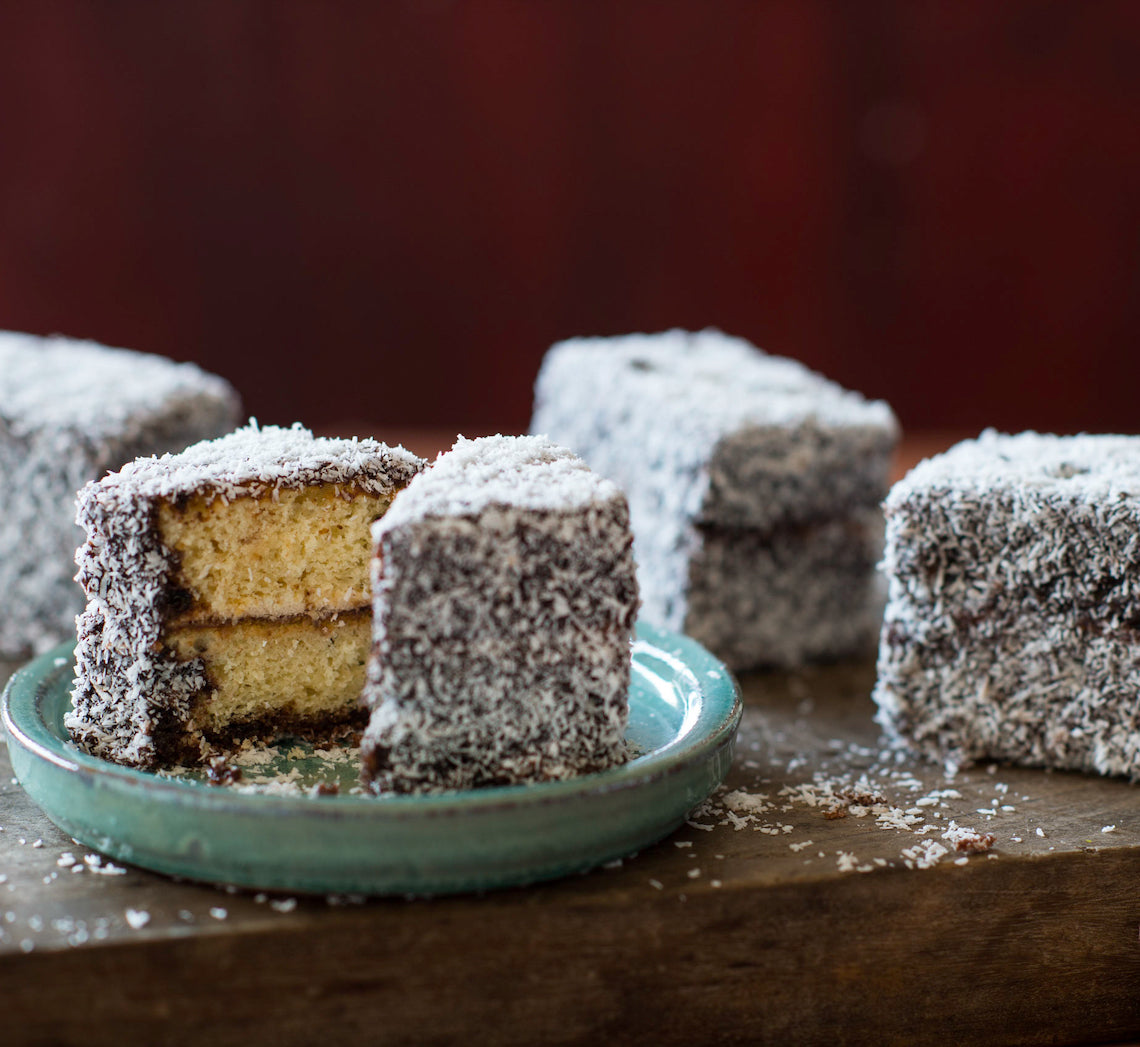
Prep 40min (+ 40min cooling and 20min chilling time)
Bake 20minMakes 9
Gluten-free cakes are sometimes hard to come by. Moist and flavoursome, these lamingtons won’t disappoint. Those with gluten or wheat intolerances and sensitivities won’t ever have to compromise if wanting to enjoy this Australian classic.
Ingredients
80ml (⅓ cup) thickened cream, whisked to firm peaks180g (2 cups) desiccated coconut, to coat
Gluten-free buttercake
175g (1¼ cups) purchased gluten-free plain flour mix2½ teaspoons gluten-free baking powder
165g (¾ cup) caster sugar
125g unsalted butter, cubed, softened
2 eggs, at room temperature
80ml (⅓ cup) milk
2 teaspoons natural vanilla extract or essence
Chocolate icing
465g (3¾ cups) pure icing sugar55g (½ cup) cocoa powder
150ml boiling water
1½ teaspoons vanilla essence
Method
- To make the gluten-free buttercake, preheat the oven to 180°C. Grease a 20 x 30cm (base measurement) shallow cake tin and line the base and two longs sides with one piece of baking paper.
- Put the flour, baking powder, sugar, butter, eggs, milk and vanilla in a large mixing bowl. Use an electric mixer to beat on low speed until combined. Increase the speed to medium and beat for 3 minutes or until the mixture is well combined and very pale in colour. Spoon the mixture into the lined tin and spread evenly using the back of a spoon. Lightly tap the tin on the bench 3 times to get rid of any excess air bubbles.
- Bake for 20 minutes or until cooked when tested with a skewer. Cool for 5 minutes in the tin, then turn onto a wire rack to cool completely (this will take about 40 minutes).
- To make the Chocolate Icing, sift the icing sugar and cocoa powder into a medium bowl. Add the boiling water and vanilla and stir until smooth (it should be the consistency of pouring cream).
- Trim the edges of the cooled cake and then cut in half to form two layers about 20 x 15cm. Spread one half of the cake with a little of the Chocolate Icing and then spread whipped cream. Top with the remaining cake half. Chill for 20 minutes or until the cream is firm enough to cut the cake.
- Use a sharp serrated knife to cut the layered cake into 9 portions (about 6.5 x 4.5cm each). Run a palette knife around the cut surface of each lamington to remove any excess cream.
- Spread the coconut on a tray or plate. Rest a cake portion on a fork, dip into the chocolate icing and then and spoon the icing over the top and sides to completely coat. Allow any extra icing to drip off. Roll the cake in the coconut to coat evenly. Place on a wire rack. Repeat with the remaining cake portions, icing and coconut.
Baker's Tips
- If the icing becomes too thick while you are coating the cake pieces, stir in enough extra boiling water, adding it a teaspoon at a time, to thin to the right consistency.
- These lamingtons will keep in an airtight container in the fridge for up to 2 days. Stand at room temperature for at least 30 minutes before serving.
This recipe is from Anneka's SBS Food online column Bakeproof: Lamingtons. CLICK HERE for more Bakeproof recipes.
Photography by Alan Benson.
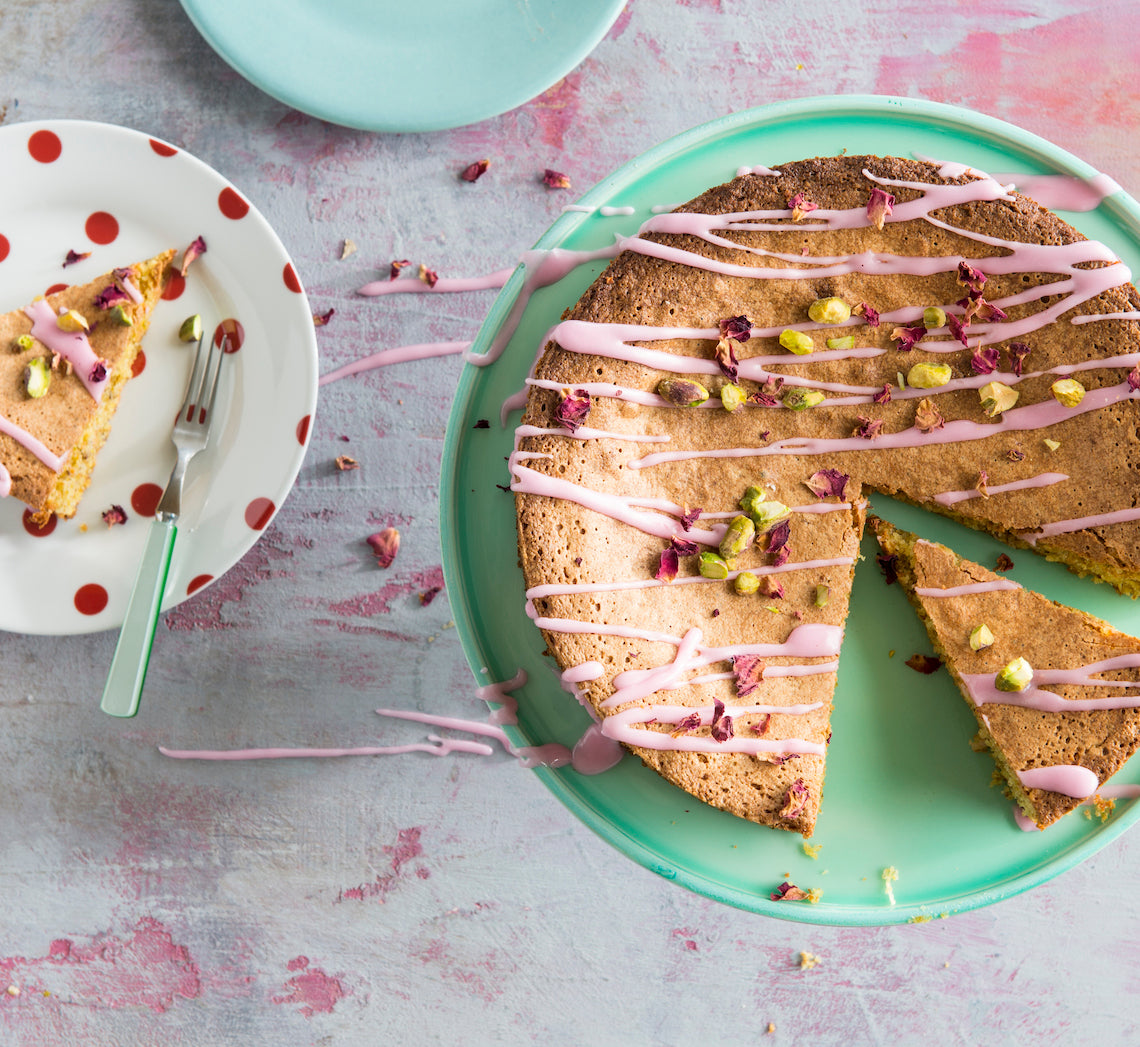
Prep 30min (+1hr cooling time)Bake 30minMakes 8-10 serves
This gluten-free and dairy-free recipe, with its subtle lemon flavour teamed with an aromatic rosewater icing and light nutty texture, is the perfect afternoon-tea cake. It will dip slightly in the centre due to its delicate nature but this is just a sign of how lovely and light it is.
Ingredients
Light olive oil, to grease
100g (1 cup) almond meal
100g (¾ cup) raw unsalted pistachios, toasted and finely ground
90g (½ cup) instant polenta or wholegrain corn flour
2 teaspoons gluten-free baking powder
3 eggs, at room temperature
165g (¾ cup) caster sugar
125ml (½ cup) light olive oil
1 lemon, rind finely shredded, juiced
extra raw unsalted pistachios, toasted and coarsely chopped, to decorate
dried rose petals (optional), to decorate
Lemon and rosewater icing
125g (1 cup) pure icing sugar
1 tablespoon (about) strained fresh lemon juice
1 teaspoon rosewater
gluten-free pink or rose food colouring, to tint
Method
- Preheat oven to 180°C (160°C fan-forced). Brush a 20cm springform cake tin with olive oil and line the base with non-stick baking paper.
- Place the almond meal, ground pistachios, polenta and baking powder in a medium bowl and use a whisk to stir to combine and remove any lumps. Set aside.
- Use an electric mixer with a whisk attachment to whisk the eggs and sugar on medium-high speed until thick and pale and a ribbon trail forms when the whisk is lifted. Whisk in the olive oil, 2 tablespoons of the lemon juice and the lemon rind.
- Add the dry ingredients to the egg mixture and use a spatula or large metal spoon to fold until evenly combined. Pour into the prepared cake tin and bake for 30 minutes or until a skewer inserted in the centre comes out clean. Stand the cake in the tin on a wire rack for 10 minutes before removing the sides of the tin. Set aside to cool completely.
- To make the lemon and rosewater icing, sift the icing sugar into a medium bowl. Gradually stir in the 1 tablespoon lemon juice and the rosewater until the mixture is smooth and has a thick coating consistency, adding a little more juice if needed. Cover with plastic wrap and set aside at room temperature until ready to use.
- Drizzle the cooled cake with the icing and then sprinkle with extra pistachio nuts and dried rose petals, if using. Set aside for 30 minutes or until the icing has set before serving in wedges.
Baker's Tips
- This cake will keep in an airtight container at room temperature for up to 4 days.
This recipe is from Anneka's SBS Food online column Bakeproof: Gluten-free baking. Click here for more Bakeproof columns and recipes.
Photography by Alan Benson.
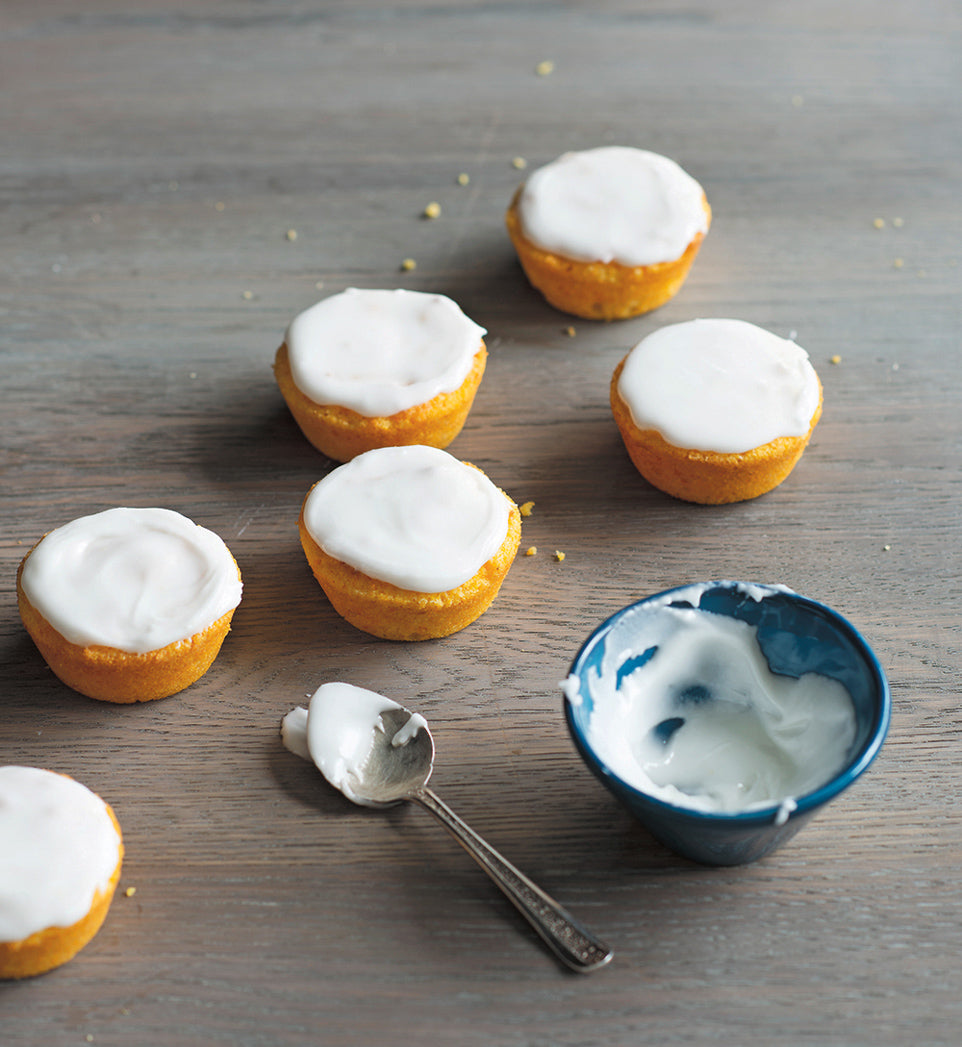
Prep 20min (+ 30-60min simmering, cooling and 20min standing time)Bake 15-18minMakes 12
These cakes are a play on the original (and wonderful) Middle Eastern Orange Cake from the one and only Elizabeth David. Making use of seasonal mandarins and with the addition of coconut and polenta, this version is also flourless and gluten-free.
Ingredients
2 large mandarins (about 110g)
Melted butter, to grease
100g (1 cup) almond meal
95g (½ cup) instant polenta
45g (½ cup) desiccated coconut
½ teaspoon gluten-free baking powder
3 eggs, at room temperature
165g (¾ cup) caster (superfine) sugar
1½ teaspoons natural vanilla extract or essence
250g (2 cups) pure icing (confectioners') sugar
1½–2 tablespoons mandarin juice
Method
- Put the whole mandarins in a small saucepan, cover with water and set over high heat. Bring to the boil, reduce the heat and simmer for 30–60 minutes, or until very soft when tested with a skewer. (You may need to place a small saucer over the mandarins to keep them submerged.) Remove the mandarins from the water and set aside to cool slightly.
- Meanwhile, preheat the oven to 180°C (160°C fan-forced). Brush a 12-hole 80ml (⅓ cup) capacity silicone or metal muffin tin with melted butter to grease. Quarter the mandarins and remove and discard the centre core and any seeds. Purée the skin and flesh in a small food processor or blender until smooth.
- Put the almond meal, polenta, coconut and baking powder in a medium bowl and mix well to combine.
- Put the eggs, sugar and vanilla in a medium bowl and use an electric mixer with a whisk attachment to whisk on high speed until very thick and pale and a ribbon trail forms when the whisk is lifted (about 3–4 minutes).
- Add the mandarin purée to the egg mixture and use a spatula or large metal spoon to fold in until just combined. Add the polenta mixture and fold together until combined. Divide the mixture evenly among the muffin holes (you can pour it from a jug or use a ladle).
- Bake in the preheated oven for 15–18 minutes, or until a skewer inserted in the cakes comes out clean. Cool the cakes in the tin for 5 minutes. Use a palette knife to ease the cakes out and transfer to a wire rack to cool.
- To make the Mandarin icing, sift the icing sugar into a medium bowl. Gradually stir in the juice until the mixture is smooth and has a thick coating consistency, adding a little more juice if too thick. Cover with plastic wrap and set aside at room temperature until ready to use.
- Spread the tops of the cooled cakes with the icing. Set aside for 20 minutes or until set.
Baker's Tips
- These cakes will keep in an airtight container in a cool place (but not in the fridge) for up to 2 days.
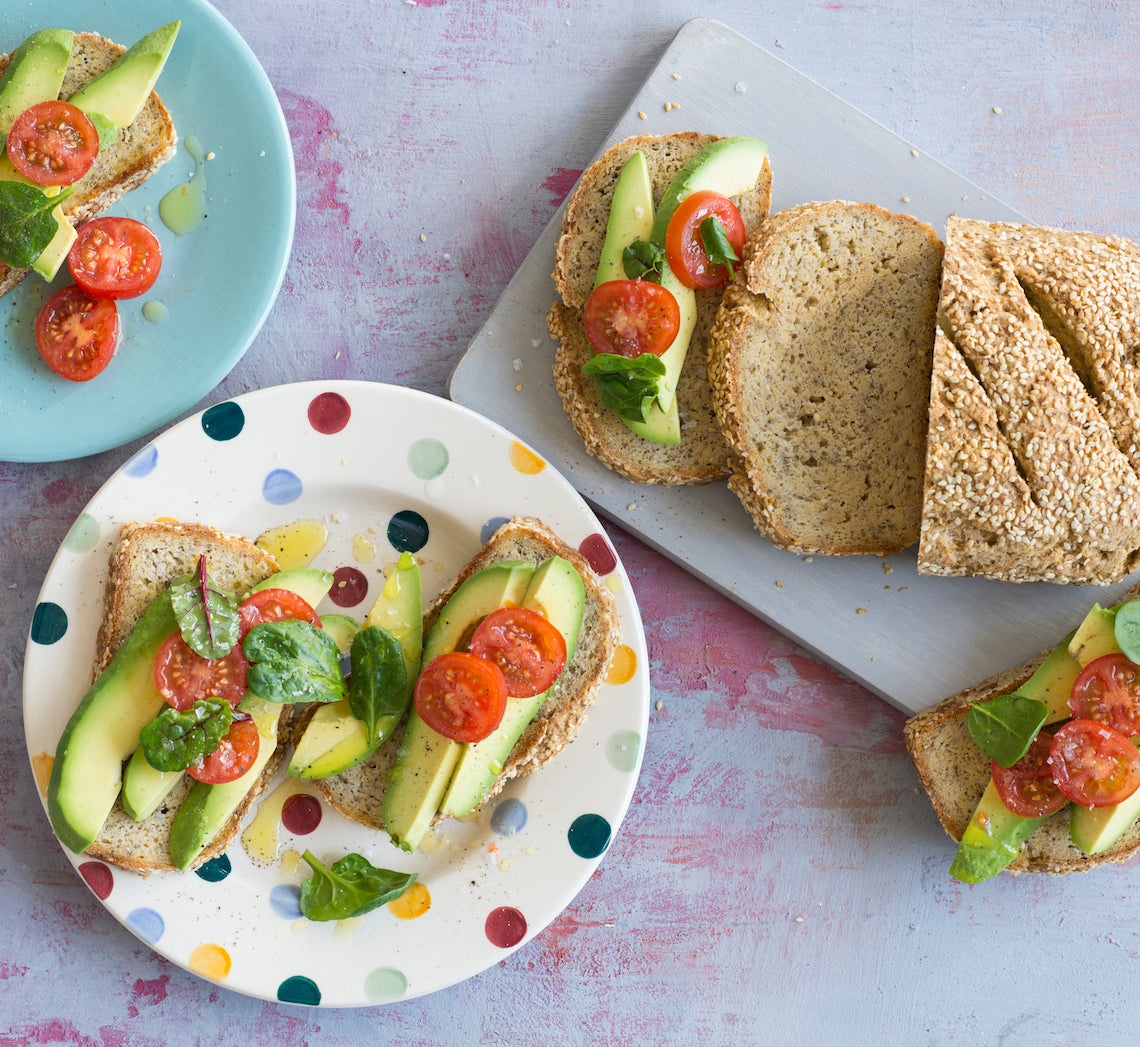
Prep 30min (+1hr30min cooling time)Bake 1hr 10minMakes 1 loaf
This bread is almost the complete opposite of most commercially made gluten-free breads - wonderfully substantial (it won’t ‘dissolve’ in your mouth), moist and flavoursome without containing any gums. The key is the inclusion of psyllium husks and chia seeds to give the dough flexibility and structure in the absence of gluten. It’s great fresh, but toasting really brings out the nuttiness of the flours used.
Ingredients
150g (1 cup) sorghum flour
75g (½ cup) millet flour
70g (½ cup) brown rice flour
65g (½ cup) sweet (glutinous) rice flour
90g (½ cup) fine polenta
1½ teaspoons fine sea salt
625ml (2½ cups) lukewarm water
7g (1 sachet) instant dried yeast
2 tablespoons honey
2 tablespoons light olive oil, plus extra to grease
25g (⅓ cup) psyllium husks
50g (¼ cup) chia seeds
2 tablespoons sesame seeds, to coat and sprinkle
Method
- Combine the sorghum, millet, brown rice and sweet rice flours, polenta and salt in a large bowl.
- Combine 60ml (¼ cup) of the lukewarm water, yeast and 1 teaspoon of the honey in a small dish and whisk to combine with a fork. Set aside in a warm, draught-free place for 5 minutes or until frothy.
- Meanwhile, use a balloon whisk to whisk together the remaining 560ml (2¼ cups) lukewarm water, remaining honey, olive oil, psyllium husks and chia seeds until evenly combined. Set aside for 3 minutes or until the mixture thickens slightly.
- Whisk the yeast mixture into the psyllium husk mixture. Add to the dry ingredients and use a wooden spoon to mix to a soft, slightly sticky dough.
- Cover the bowl with plastic wrap and set aside in a warm, draught-free place for 1½ hours or until risen slightly and is spongy in texture.
- Grease a 11.5cm x 21cm (base measurement) loaf tin with a little extra oil and sprinkle with 1½ tablespoons of the sesame seeds to coat lightly. Turn the dough onto a benchtop, shape into a 20cm log and place in the greased tin. Brush the top with a little water and sprinkle with the remaining sesame seeds. Cover with plastic wrap and set aside and place in a warm, draught-free place for 1 hour or until well risen.
- Preheat the oven to 200°C (180°C fan-forced).
- Use a sharp knife to cut 4 diagonal slits across the top of the loaf. Bake 1 hour and 10 minutes or until golden, cooked through and sounds hollow when tapped on the top.
- Turn the loaf out onto a wire rack and set aside to cool completely - this will take about 1½ hours) before slicing.
Baker's Tips
- This bread is best kept in a cloth or paper bag at room temperature in a cool spot where it will keep for up to 5 days.
- To freeze, place whole or sliced in a sealed freezer bag or airtight container and freeze for up to 3 months. Thaw at room temperature or toast slices straight from the freezer.
This recipe is from Anneka's SBS Food online column Bakeproof: Gluten-free baking. Click here for more Bakeproof columns and recipes.
Photography by Alan Benson.
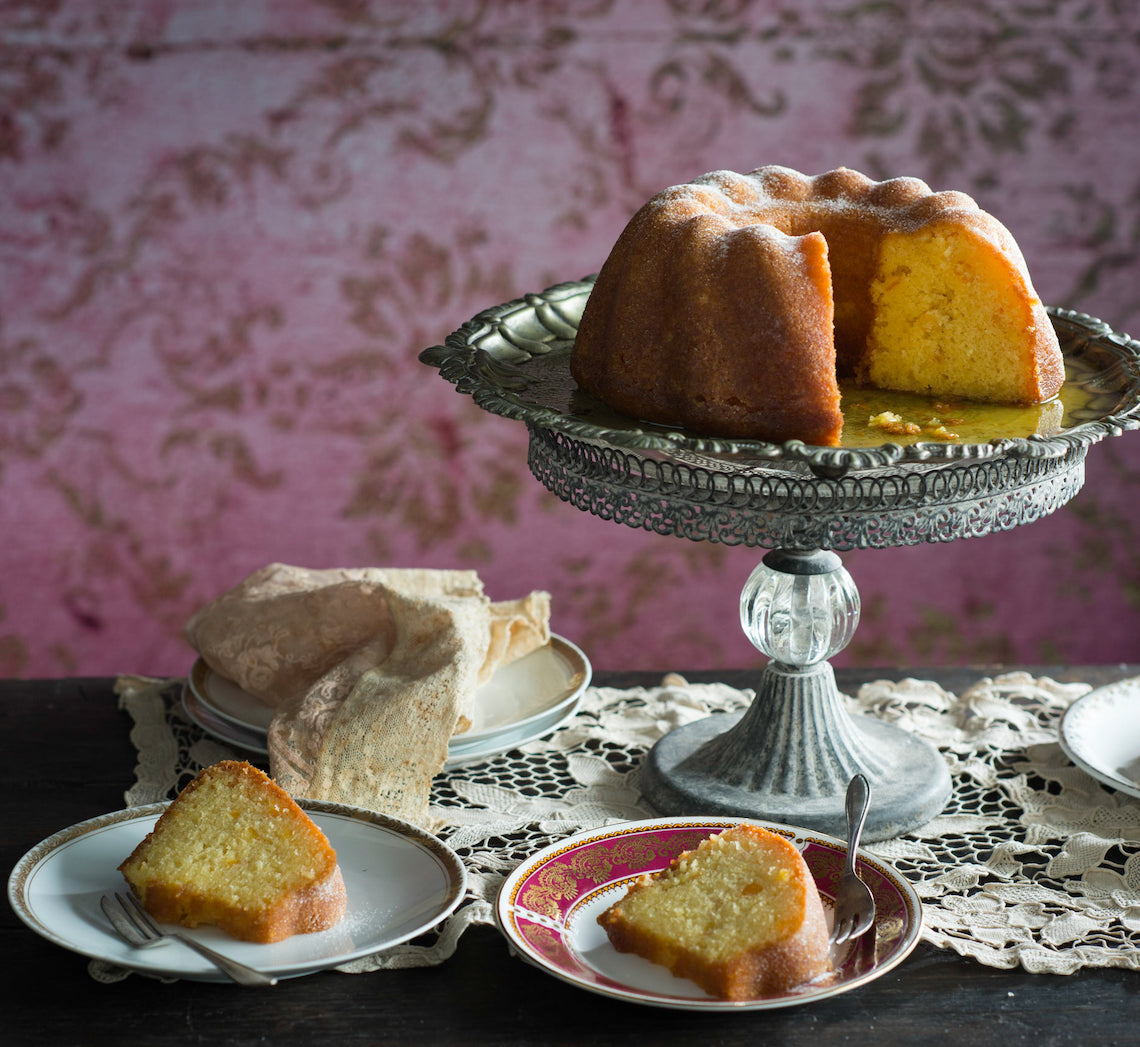
Prep 30minBake 50minMakes 12 serves
Originally a cake of the poor, Gugelhupf is a firm staple in Austria and is of the most popular afternoon tea offerings especially in the local kafes (coffee houses). But, as Emperor Franz Josef preferred, it is often eaten for breakfast. There seem to be as many variations of this yeast or sponge-based cake as there are days in the year – this one has a luscious orange syrup to keep it lovely and moist.
Ingredients
20g (¾oz) butter, melted, combined with 1½ teaspoons plain flour, to grease
250g (9oz) unsalted butter, at room temperature
125g (1 cup/4½oz) icing sugar, sifted
2 teaspoons natural vanilla essence or extract
4 eggs, at room temperature, separated
250g (1⅔ cups/9oz) plain flour, plus extra to dust
1½ teaspoons baking powder
Good pinch of salt
75g (2¾oz) candied orange rind
110g (½ cup/4oz) caster sugar, plus 1 tablespoon extra to sprinkle
Orange Syrup
250ml (1 cup/9fl oz) strained fresh orange juice
145g (⅔ cup/5oz) caster sugar
50ml (2½ tablespoons/1¾fl oz) orange liqueur
Method
- Preheat oven to 180°C/350°F (160°C/315°F fan-forced). Brush a 2.5 litre/5.25pt (24cm/ 9½in diameter) bundt tin with the melted butter and flour mixture to grease.
- Use an electric mixer to beat the butter and icing sugar and vanilla until pale and creamy. Add the egg yolks and beat until well combined and creamy.
- Sift together the flour, baking powder and salt and then stir through the candied rind. Use an electric mixer with a whisk attachment to whisk the egg whites with the salt until soft peaks form. Add the caster sugar and whisk until thick and glossy. Use a large metal spoon or spatula to fold the egg whites into the butter mixture until evenly combined. Then gently fold in the flour mixture until just combined.
- Spoon the mixture into the prepared tin and smooth the surface with the back of a spoon. Bake in preheated oven for 45-50 minutes or until a skewer inserted comes out clean. Stand in the tin for 5 minutes before turning onto a plate with a lip.
- Meanwhile, to make the Orange Syrup, combine the orange juice and sugar in a small saucepan and stir over medium heat until the sugar dissolves. Bring to a simmer and then remove from the heat. Stir in the orange liqueur.
- Slowly pour the hot syrup over the hot cake, allowing it to soak in as much as possible. Sprinkle with the extra caster sugar and cool to room temperature (this will take about 1 hour). Serve in slices for morning or afternoon tea or dessert on its own or with cream.
Baker's Tips
- This cake will keep in an airtight container at room temperature for up to 3 days.
This recipe is from Anneka's SBS Food online column, Bakeproof: Austrian Baking.
CLICK HERE for more Bakeproof recipes.
Photography by Alan Benson.
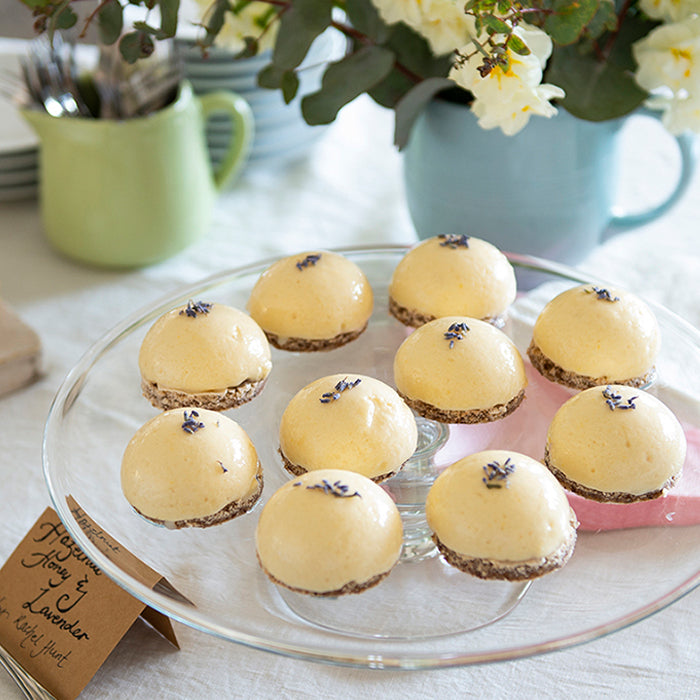
Prep 2 hours (+ 4 hours chilling time)Bake 30-40 minMakes 18 serves
These divine desserts petite gateaux were created by Rachel Hunt, one of our Make Me a Baker students for her graduation. A crisp, nutty, meringue base is topped with a mirror-glazed, ever-so-light honey-infused mousse surrounding a floral lavender jelly. Using a number of techniques, this recipe showcases all the fantastic new skills and confidence Rachel gained over the course of our 6-month program and, lucky for you, she’s sharing it so you can make them at home! Rachel uses 18 x 30mm and 60mm (top measurement) half sphere silicon moulds however other shapes/sizes can be used.
Ingredients
Lavender Jelly- 6 fresh unsprayed lavender heads or 2 teaspoons
dried culinary lavender, plus extra to decorate - 250ml (1 cup) water
- 110g (1/2 cup) sugar
- 1½ teaspoons powdered gelatin
- 2½ tablespoons cold water
- Purple food colour (optional)
- 5 eggs, separated
- 40g butter, diced
- 135g good-quality white chocolate chips (like Callebaut)
- 60ml (¼ cup) good-quality honey
- 2 teaspoons powdered gelatin
- 2 tablespoons cold water
- 300ml thickened cream
Hazelnut Meringue
- Vegetable oil, to grease
- 150g hazelnut meal or peeled toasted hazelnuts
- 7 large egg whites
- ½ teaspoon white wine vinegar
- 385g (1¾ cups) caster sugar
Mirror Glaze
- 2 tablespoon powdered gelatin
- 250ml (1 cup) cold water
- 330g (1½ cups) caster sugar
- 160ml (2/3 cup) sweetened condensed milk
- 2 cups good-quality white chocolate chips (like Callebaut)
Method
- To make the lavender jelly, combine the sugar and 250ml water in a small saucepan and stir over a low heat until sugar dissolves. Bring to the boil. Remove from the heat and add the lavender. Set aside to cool to room temperature.
- When the syrup is almost cool, place the cold water in a small heatproof bowl or dish and sprinkle the gelatin over. Set aside for 5 minutes or until the gelatin is fully rehydrated. Sit the bowl or dish into another bowl of hot water and stir until dissolved and the mixture is clear.
- Strain the jelly syrup through a sieve to remove the lavender. Transfer the gelatin mixture to a medium bowl and stir in the syrup until well combined.
- Tint the jelly syrup with purple food colouring if desired. Place 18 x 30mm (top measurement) half-sphere silicon moulds on a tray and pour in the jelly syrup (there will be some syrup left over and you can set it in other moulds or glasses if you wish). Place in the fridge to chill for at least 4 hours, or until well set.
- To make the honey mousse, lightly whisk the egg yolks and combine in a medium saucepan with the butter, chocolate and honey. Stir over low heat until the chocolate is just melted (be careful not to overheat). Transfer mixture to a large bowl.
- Place the cold water in a small heatproof bowl or dish and sprinkle the gelatin over. Set aside for 5 minutes or until the gelatin is fully rehydrated. Sit the bowl or dish into another bowl of hot water and stir until dissolved and the mixture is clear. Stir gelatin mixture into the chocolate mixture until combined. Cover and cool to room temperature, stirring occasionally.
- Use an electric mixer with a whisk attachment or a hand-held balloon whisk to whisk the cream in a medium bowl until soft peaks form. Fold the cream into the cooled chocolate mixture until just combined. Whisk the egg whites with a clean whisk in a large bowl until soft peaks form. Add half the egg whites into the chocolate mixture and gently fold through. Add the remaining egg whites and gently fold through until just combined.
- Place 18 x 60mm (top measurement) half sphere moulds on a tray and pour in the mousse mixture to fill each until almost full. Remove the lavender jelly domes from the smaller moulds and press into the centre of each individual mousse, ensuring the mousse completely covers the jelly. If the jelly isn't completely covered, add a little more mousse. If necessary, scrape a palette knife across the top of the moulds so that the base of the mousse domes will be level. Chill for at least 4 hours, or until set.
- To make the hazelnut meringue, preheat the oven to 180°C (160°C fan forced). Lightly grease 2 oven trays and line with non-stick baking paper.
- If using whole toasted hazelnuts grind the nuts with 1 tablespoon of the caster sugar in a food processor until fine but still with some texture.
- Use an electric mixer with a whisk attachment to whisk the egg whites and vinegar until soft peaks form. Add the caster sugar 1 tablespoon at a time, whisking well after each addition. Once half the sugar has been added start adding the rest in larger quantities, whisking well after each addition, until stiff, glossy peaks form. Use a metal spoon or spatula to fold the hazelnuts through the meringue. Spoon the meringue onto the prepared trays and spread evenly in a rectangle until about 1-1½cm thick. Bake in preheated oven for 30-40 minutes until a crisp crust forms. Remove from the oven and cool for 20 minutes on the trays and then transfer them to wire racks, still on the baking paper, to cool completely. Carefully remove the baking paper and transfer to a cutting board. Use a 6cm round cutter to cut discs from the meringue sheets. Set aside in an airtight container.
- To make the mirror glaze, place 80ml (1/3 cup) of the cold water into a small bowl or dish and sprinkle the gelatin over. Set aside for 5 minutes or until the gelatin is fully rehydrated.
- Combine the remaining water, sugar and condensed milk in a small saucepan over a medium heat. Stir occasionally until the mixture begins to bubble. Remove from the heat, add the gelatin mixture and stir until fully dissolved. Add the white chocolate chips and stir slowly until melted. Pour the mixture through a sieve into a large jug and set aside to cool to room temperature.
- Remove the petit gateaux domes from the fridge and place on a wire rack over a larger oven tray to catch the drips. Carefully and slowly pour the glaze over ensuring the domes are completely covered. Sprinkle dried lavender on top to decorate if desired.
- Set aside at room temperature for at least 20 minutes or until the glaze is set.
- Use a palette knife to transfer the mousse domes to the hazelnut meringue discs and serve.
Baker's Tips
- The mousse domes will keep in an airtight container in the fridge for up to 2 days.
- The Hazelnut meringue will keep in an airtight container at room temperature for up to 1 week.
Rachel took inspiration for her creation from:
https://www.deliciousmagazine.co.uk/
https://www.womensweeklyfood.com.au/
https://chelsweets.com
https://ballymaloe.ie/content/ballymaloe-recipes
Photography by Alan Benson.
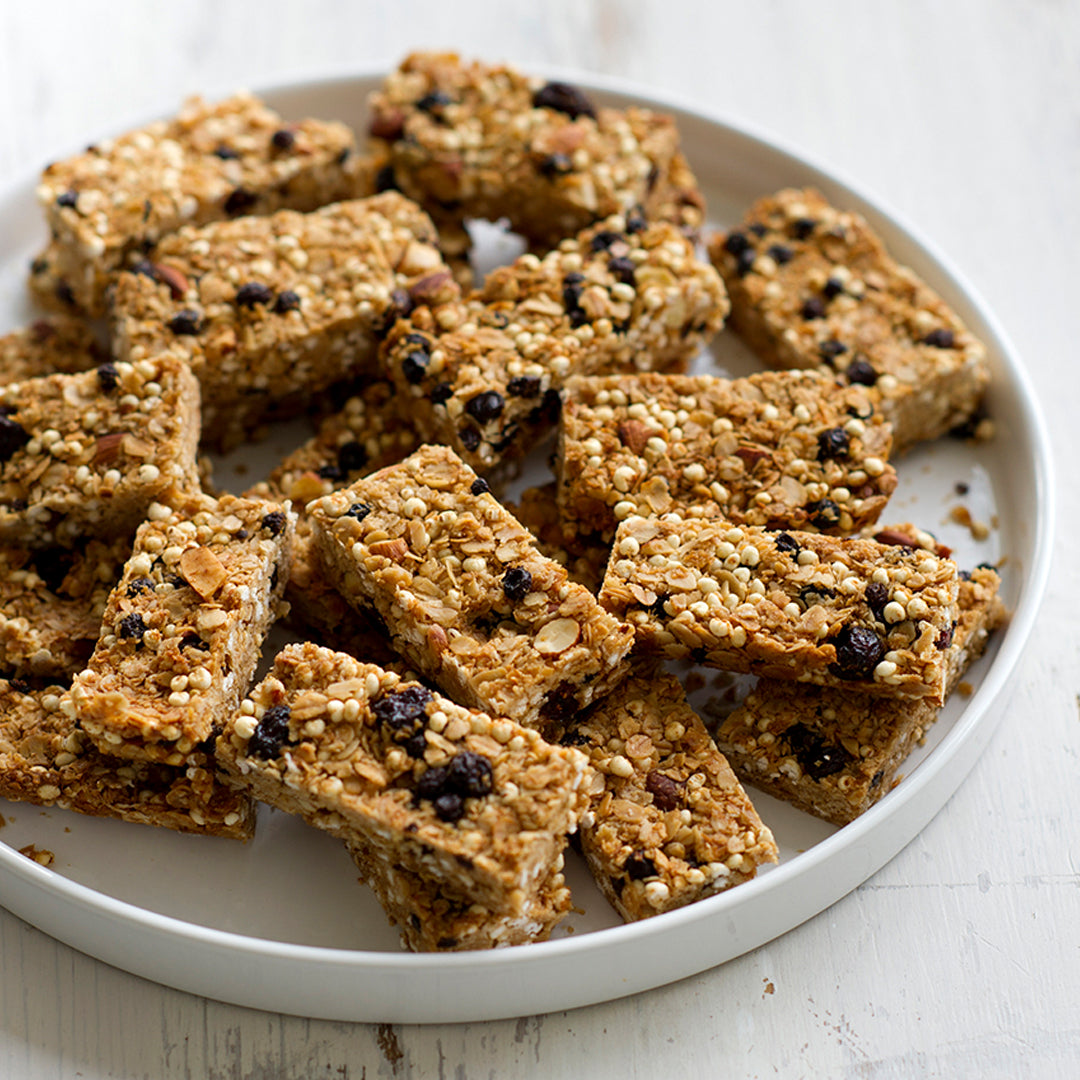
Prep 15min (+ cooling time)Bake 45-55minMakes about 24
Knowing what is going into your muesli bars is the key to good ones – it makes them so much healthier and tastier.
Ingredients
260g (180ml / ¾ cup) good-quality honey
125ml (½ cup) sunflower oil or light olive oil
250g (2½ cups) rolled oats
30g (1½ cups) puffed millet
45g (½ cup) desiccated coconut
1½ teaspoon ground cinnamon
55g (⅓ cup) sweetened dried cranberries
75g (½ cup) currants
80g (½ cup) raw almonds, coarsely chopped (see Baker’s Tips)
Method
- Preheat the oven to 140ºC (120°C fan-forced). Lightly grease a shallow 20 x 30cm (base measurement) slice tin and line the base and sides with non-stick baking paper.
- Put the honey and oil in a small saucepan over medium heat and stir until well combined and heated through. Set aside.
- Put the rolled oats, millet, coconut, cinnamon, cranberries, currants and almonds in a large bowl and mix to combine evenly. Add the honey mixture and stir to combine well. Using damp hands, press the mixture firmly into the lined tin. Press the mixture with the back of a spoon to make the surface smooth and even.
- Bake for 45–55 minutes or until the surface is dark golden brown all over. Cool completely in the tin before cutting into 24 bars with a sharp knife.
Baker's Tips
- For a nut-free version, substitute the almonds with ⅓ cup sunflower seeds or pepitas (pumpkin seeds).
- These muesli bars will keep in an airtight container at room temperature for up to 1 week. Alternatively they also freeze well for up to 3 months – wrap individual bars in plastic wrap and then seal in an airtight container or freezer bag. Thaw at room temperature.
- For extra-crisp muesli bars, store in an airtight container in the fridge.
$100.00/pp
more info- Products -
Learn to bake the most traditional of Easter breads – just in time for the Easter weekend – in this fun and casual online baking class.
Hot Cross Buns LIVE will take place again in 2026. Please email us to express your interest.
I had never made Hot Cross Buns as they always seemed too difficult. I always enjoy Anneka's way of teaching – I find I learn so much and I love the way she supports her teachings with the science behind it. I find the live sessions work really well, and I learn so much from them ... being able to ask questions live is such a bonus. This course is a great way to learn something which you think is difficult but Anneka makes it all so simple. Absolutely do it!
Christine, NSW
Learn to bake the most traditional of Easter breads – right in your very own kitchen!
Hot Cross Buns is a fun and casual 2.5-hour LIVE virtual baking class where you will learn to make your own traditional Hot Cross Buns – just in time for the Easter weekend!
Anneka Manning will take you through the process step by step, sharing all of her practical tips and tricks along the way. You will have the ability to bake along with her as well as ask any questions that arise as you mix, knead, prove and shape your dough together throughout the evening. You can either bake your buns immediately or Anneka will share how to prove the dough overnight so it's ready to bake first thing the next morning.
The virtual Live Session will be supported by printable recipes and resources which will become your go-to Hot Cross Bun baking kit every Easter. Anneka will also share a number of recipe variations and some ideas of what to do with leftovers (if there are any!)
At the end of this class, you will come away not only with new-found skills and confidence but a dozen just-baked warm buns ready to smother in butter!
Date
Hot Cross Buns is not currently scheduled. If you are interested in taking part in 2026, please contact us to express your interest.
Please note: The Live Session will be recorded and available for you to watch afterwards if you are unable to attend, or rewatch it at a later date if you would like to.
Cost
$100 (Half price for all BakeClub & Co. Members).
Student numbers
We will only be accepting a limited number of bakers for this class so that Anneka can answer your baking questions during the Live Session and provide personal feedback.
I definitely got more than I expected from the class. Easy step-by-step instructions provided by Anneka and the opportunity to ask questions, no matter how 'silly', while making the buns meant I got the best experience possible. It was just perfect. Definitely recommend.
Glynis, Melbourne
Who is this class suitable for?
This class is, quite simply, suitable for everyone – from absolute beginners to more experienced bakers. As this class is completed online, it is suitable for students from all over the world.
What will I get?
- A 2.5-hour virtual live baking demonstration (which will take place on Zoom and will be recorded) where you will learn and bake along with Anneka Manning through the process of making traditional Hot Cross Buns
- Access to Anneka's baking experience, knowledge, tips and tricks, and the ability to ask her any questions that come up during the session
- A chance to learn surrounded (virtually) by like-minded people
- A complete guide to traditional Hot Cross Bun baking which you can refer to and use to troubleshoot in the future to ensure baking success year after year
- Invaluable printable resources and recipes
- Lifetime access to the live video and course material
- Membership to BakeClub's exclusive The Kitchen Table online group to continue asking questions and share your baking
- Baking confidence, knowledge and skill to use regularly at home
How will I get the most out of this class?
To get the most out of this class, you need to set aside the time to attend the Live Session with Anneka and read the support material supplied beforehand. The Live Session will be recorded so it will be available to watch at any time if you are unable to attend. However, we do recommend baking along to get the most out of the class.
What if the dates don't suit me? Can I still enrol in the class?
If the date of this class doesn't work for you, you can still enrol and take part in your own time. While you may miss out on the Live Session, it will be recorded and will be available to watch when it suits you. You will have lifetime access to the video, as well as all the course material (including all of the resources and recipes).
I enjoy Anneka's classes and always learn a lot ... It makes a difference to watch and learn, and be able to ask questions, rather than just read a recipe. It was fun and enjoyable to bake along and have Anneka give feedback. A highlight for me are all the tips and tricks from Anneka ... she is a great teacher ... and her recipe is really good!
Helen, Hong Kong
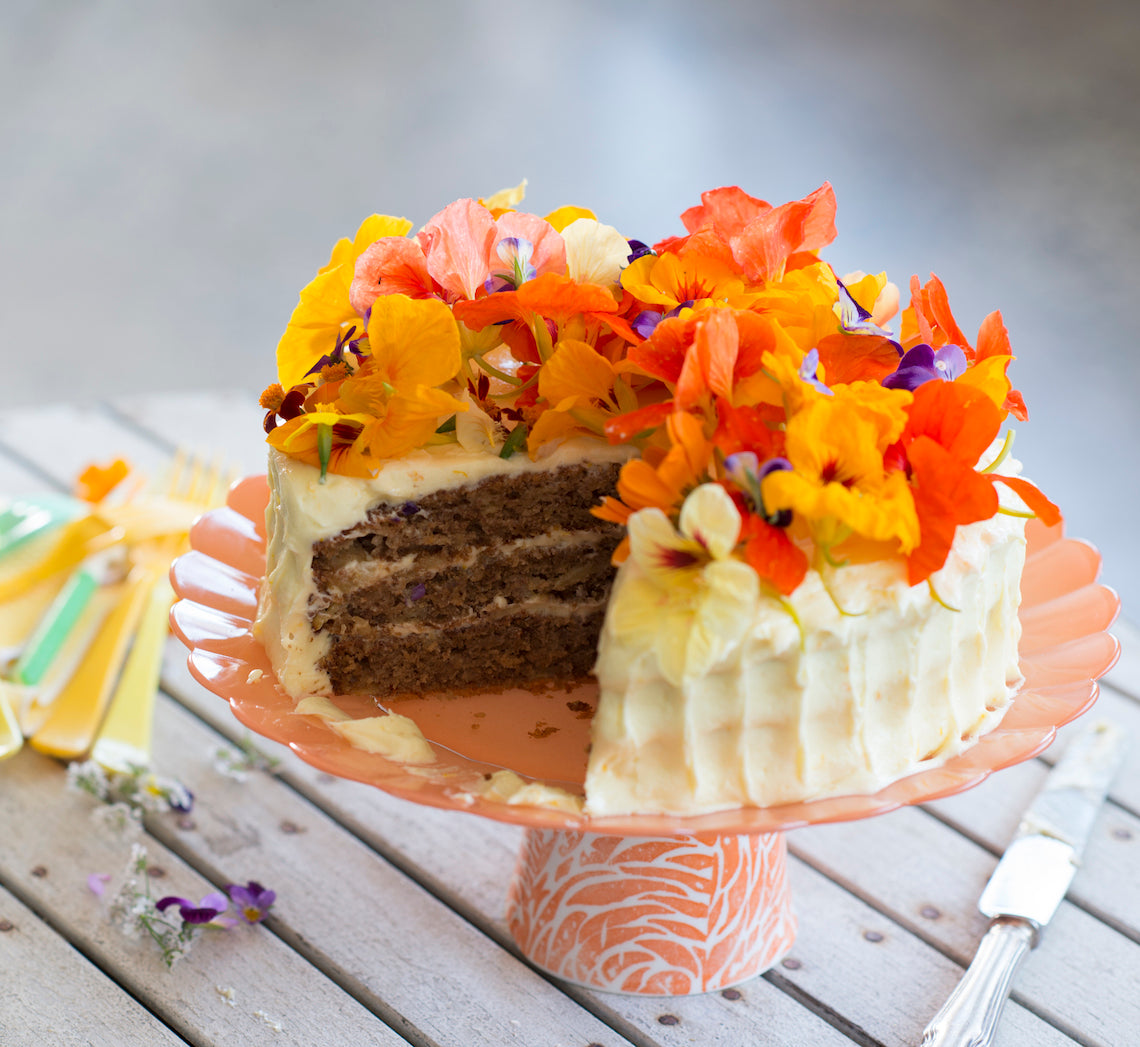
Prep 30minBake 30-35minMakes 12-15 serves
Originating (and excessively popular) in America, Hummingbird cake is a tropical mix of banana and pineapple, and when layered with an orange cream cheese frosting makes a great celebration cake. Sweet and indulgent, a small slice is all that is needed to satisfy.
Ingredients
150g (1 cup) plain flour
75g (½ cup) self-raising flour
½ teaspoon bicarbonate of soda
2 teaspoons ground cinnamon
220g (1 cup, firmly packed) brown sugar
45g (½ cup) desiccated coconut
2 very ripe large bananas (about 250g each)
440g crushed pineapple in natural juice, drained and juice reserved
2 eggs, lightly whisked
185ml (¾ cup) sunflower oil, plus extra to grease
Orange cream cheese frosting
100g unsalted butter, at room temperature
250g cream cheese, at room temperature
1 orange, zest finely grated
375g (3 cups) icing sugar mixture, sifted
Method
- Preheat oven to 180°C (160°C fan-forced). Brush three 20cm round cake tins with extra sunflower oil to lightly grease and line the bases with non-stick baking paper.
- Sift together the plain and self-raising flours, bicarbonate of soda and cinnamon. Add the brown sugar and coconut and stir to combine, breaking up any lumps.
- Mash the banana and combine with the drained pineapple, 80 ml (⅓ cup) of the reserved pineapple syrup, eggs and oil. Add to the flour mixture and use a wooden spoon or spatula to mix until just combined.
- Divide the mixture evenly among the prepared tins and spread with the back of a metal spoon to smooth the surface. Bake in preheated oven for 30-35 minutes or until cooked when tested with a skewer.
- Stand the cakes in the tins for 5 minutes before turning onto wire racks to cool (this will take about 1 hour).
- Meanwhile, to make the Orange cream cheese frosting, use an electric mixer to beat the cream cheese, butter and orange zest until very smooth. Gradually add the icing sugar, beating well after each addition and beat until well combined and really creamy. Divide the Orange cream cheese frosting evenly among 3 bowls.
- Take one portion of the Orange cream cheese frosting and use a palette knife to spread half over one cake layer. Top with a second cake layer and spread with the remaining frosting of the first portion. Top with the remaining cake layer. Spread another portion of frosting over the sides and the remaining portion over the top of the cake. Sprinkle with the pecans to decorate
Baker's Tips
- This cake will keep in an airtight container in the fridge for up to 4 days. Stand at room temperature for about 30 minutes before serving.
This recipe is from Anneka's SBS Food online column, Bakeproof: Cakes for Crowds. CLICK HERE for more Bakeproof recipes.
Photography by Alan Benson.

Prep 1-2hr (+drying time)Makes about 25 biscuits
If you're keen to show your loved one/s just how much they mean to you by baking them something irresistibly sweet, then you really can't go past a batch of these gorgeous cookies! The style of decorating used to create them is called 'flood on flood' icing and is a really effective way to decorate gingerbread or sugar biscuits. The key is to be patient, try not to rush and remember your designs will improve with practice. You will need at least three small piping bags and three Wilton or Loyal #4 round piping nozzles for this style. This Royal Icing recipe makes about 3 cups of icing and is enough to decorate about 25 average-sized cookies.
Ingredients
Gel food colours of your choice (we have used shades of 'rose pink' and 'raspberry'), to tint
About 25 gingerbread cookies
Edible sprinkles, to decorate
Royal Icing
3 egg whites (from 59g eggs) or 90g pasteurized egg whites (see Baker’s Tips)
675g (1½ cups) pure icing sugar, sifted through a fine sifter
½-3 teaspoons strained fresh lemon juice
Room temperature water, to thin icing
Method
- To make the Royal Icing, place the egg whites then the icing sugar in the bowl of an electric mixer. Use the paddle beater to beat on low speed until combined. Increase speed to medium and beat for 5 minutes. The icing will be smooth and thick at this stage. Add the lemon juice, ¼ teaspoon at a time, beating well between each addition, until the icing reaches a good piping consistency. The icing should be the consistency of toothpaste - soft but will hold its shape and form a soft peak when the beater is lifted.
- Immediately cover the bowl with plastic wrap and then a damp tea towel or cloth to prevent it from drying out (see Baker’s Tips).
- Divide the icing evenly between 3-5 small bowls (depending on how many different coloured icings you would like to use - we used 4 for these cookies including the white) and cover each bowl well. Transfer one white icing portion to a small piping bag fitted with a Wilton or Loyal #4 round piping tip (this will be used to pipe the outlines). Working with one portion of the remaining icing at a time, tint to desired colours, then add a little water, a drop at a time, and use a small palette knife or metal spoon to stir until it reaches the right consistency for ‘flooding’ (see Baker’s Tips). As soon as each portion reaches the right consistency, spoon into a small piping bag fitted with a Wilton or Loyal #4 round piping tip. Twist the end of the piping bag and seal with a clip or elastic band (this will help prevent it from drying out). Cover the tip with plastic wrap and then a damp cloth or tea towel and set aside while tinting and thinning the remaining icing portions.
- Use the white icing to pipe an outline around the inside edge of a cookie to create a border so that the icing in the centre won’t flow over the edge. Set aside for 3-5 minutes or until firm but not set.
- Pipe a tinted icing into the centre of a cookie to 'flood' it (making sure there will be enough to cover it comfortably but not too much so that the icing flows over the piped border). Use a toothpick to carefully spread the icing to cover fully, if needed, and then let the icing settle and become smooth. To achieve a ‘flood on flood’ effect (so that the pattern sinks into the base icing), while the icing is still wet, use contrasting tinted icing/s to pipe the stripes, dots or patterns onto the flooded icing (see Baker’s Tips). We created the heart pattern by piping dots and then dragging a toothpick through the dot from top to bottom and a little beyond. Sprinkle with edible sprinkles to decorate, if desired.
- Set iced cookies aside to dry completely overnight before storing (see Baker’s Tips).
Baker's Tips
- If you are concerned that these cookies will be served to pregnant women or people with compromised immune systems, use pasteurised egg whites. They are available in a carton from the refrigerated section of the supermarket.
- Royal Icing will dry out and start to set very quickly if not covered well. Cover bowls and the tips of filled icing bags with plastic wrap and then a damp tea towel while you are not using them to prevent the icing from drying out.
- To test if the icing is at the right consistency for ‘flooding’, drop a teaspoonful of the icing back into the bowl. If it melts back into the icing and the surface becomes flat in 5-6 seconds it is ready. If not, add a little more water to thin or a little more icing sugar to thicken it.
- If using the ‘flood on flood’ technique, to prevent the icing from spilling over the piped border, it is important not to over-flood the centre of the cookie with icing.
- It is best to have all the tinted icing consistencies the same for the best results for the 'flood on flood' technique. However, if two icing portions are slightly different consistencies, use the thinner one first to cover the cookie first and then use the slightly thicker one on top to create the decoration.
- If your royal icing becomes too thick during decorating, remove it from the piping bag and stir in a drop or two of water or enough to reach the desired consistency. A dropper is ideal for adding this small amount of water.
- The time it will take for the icing to dry/set will depend greatly on the weather (temperature and humidity). If humid, to assist in the drying, place the cookies on a lined tray in an oven preheated to 50°C for 30-60 minutes. Also if it is really humid, it is best to put the cookies straight into an airtight container lined with absorbent paper as soon as they cool from drying in the oven.
- These decorated cookies will keep in a single layer in a sealed airtight container lined with paper towel for up to 5 days.
- The Royal Icing will keep in a well-sealed container in the fridge for up to 3 days. Bring to room temperature to use. You may need to add a little more water to bring it to the correct consistency.


